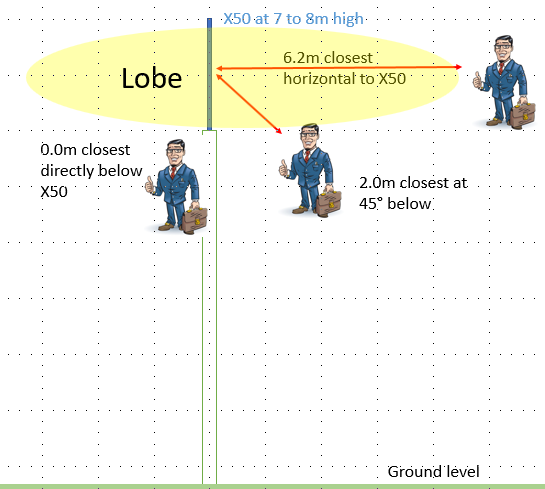![]() Tomorrow?
Tomorrow? ![]()
Ah, OK ![]()
![]() Tomorrow?
Tomorrow? ![]()
Ah, OK ![]()
Actually Nov. 18th 2022
(according to my e-mail from Ofcom)
(or are you referring to implementation of below 10MHz in the RSGB calculator?)
… that was the date in the Rad Com article but things are obviosly moving… Paul
I only use 2W BUT with the dish it becomes 450W EIRP, you have to be in the rather narrow beam. I have added the label to remind me. Keep clear by 2m in the nominal 15 degrees beam. That should be enough documentation in the field to cover the worst case transmission.
73 de
Andrew G4VFL
This is going to seem like a stupid question Andrew but, I didn’t realize you could use a dish to transmit on the bands. Which bands do they use and how big is it please also could you put a photo of it on please.
This will slightly move this thread off track so I will be brief.
GM13 group and the West of Scotland ARS have a few notes and pictures on the recent activation.
There are two modes Pt2Pt and via the OSCAR 100 satellite there is a WEB SDR if you want to listen.
The disk is 50cm offset
As you see there are parts but you have to do your own system intergration. There are also many other configurations to work OSCAR 100 (QO-100).
73 de
Andrew G4VFL
Thanks Andrew and sorry if I took it off topic
I am concerned that many models of the radiation (presumed to cause health problems) are apparently designed for microwave services where the antenna is physically small compared with the size of a human. But for HF the antennas can be very large wrt a human.
Does anyone have comments on how the field strengths of concern are located on a HF antenna, eg. Is the high current part of the antenna (highest magnetic field) where the highest radiation of concern is found or is it the high voltage part of the antenna (highest electrostatic field)? I think that information is essential to help you work out what type of antenna you use and how you would erect it, eg by placing the ends high enough to be out of reach, or would you resolve to always have a feedline of a certain length to ensure separation from the antenna wire. Does this radiation concern mean that antennas without feedlines are not to be used?
Andrew VK1DA/VK2UH
Yes Andrew, the calculator is taking that angle - the simple far-field case - just flagging a warning if the calculated separation distance according to far field comes out within the near field.
But the PAC1 document cited above by G4IPB goes into much greater depth about E & H near field with modelling of dipoles over various ground types. But even so it seems to say separation distances for a low HF inverted vee coming near to the ground (the worst case for E) are not so much, even for a lot more power than I’ll be running off battery. This is just the sort of modelling we needed.
Revised guidance published today:
I’ve downloaded the latest EMF compliance spreadsheet from the RSGB website. It took only a minute or so to fill out for my FT857 and X50 (8m up on a bracket on my chimney) for 20W 2m FM. It says I need to go to the next step (e.g. look at the OfCom diagram).
I’ve redrawn it to help me make sense of it by moving the OfCom man [yes that’s him] in free space around the colinear.

Any comments?
Horizontal separation needed is 0.0m so you are compliant. It’s as simple as that.
The “vertical separation” number is confusing - it’s the calculated distance from the top of the head of a nominally 1.8m tall person to your antenna ! If you move the antenna height you will see that change.
The “OFCOM distance” is 2m - as long as nobody can get within 2m of your antenna in any plane you’re safe.
Cheers
Rick
But you would probably need to add a few conditions to anticipate possible questions.
Eg. What would happen if someone were working in the loft or on the roof ? You just need to state that in those situations you would know that they were present and not transmit.
Presumably you have control of who is in the loft or on the roof so it is a non issue. What matters is whether someone can enter the zone while you are transmitting.
My wife often goes in the loft to fetch something without telling me 
Actually my bungalow loft is an attic conversion so there could well be someone there. However, the X50 is on an aluminum pole with the bottom of the collinear above the highest point of the roof (thereby exceeding the horizontal distance of 0.0m). The chimney/pole/X50 is on the side of the house with the roof sloping upwards and further away. The diagonal line from the bottom of the X50 into the upstairs living space is about 4m (twice that needed for OfCom compliance distance).
Yes, I wouldn’t be transmitting if someone were working on the roof. Instead I’ll be carefully watching any workman within 2m of my X50 to make sure he doesn’t damage it!
I’ll add the above as comments on the form.
At least version 11 of the RSGB calculator has removed the need to input the Directivity “fiddle factor” for VHF arrays.
Remember the Ofcom compliance on November 2021 only applies to frequencies above 110MHz so KISS. We have 12 months from that date to sort out calculator versions 12, 13, 14… for use on frequencies below 110MHz
PS if your really really really understand the implementation of the term Directivity please step forward!
Regards
David G0EVV